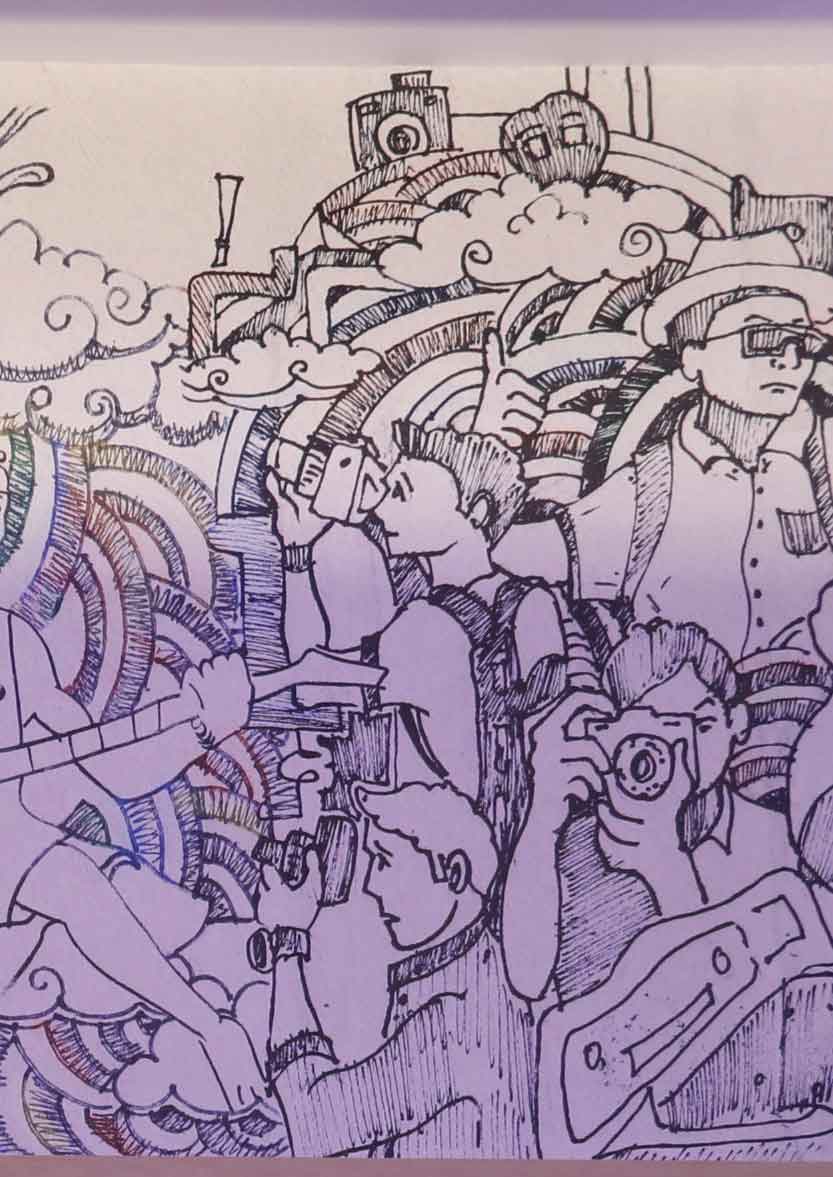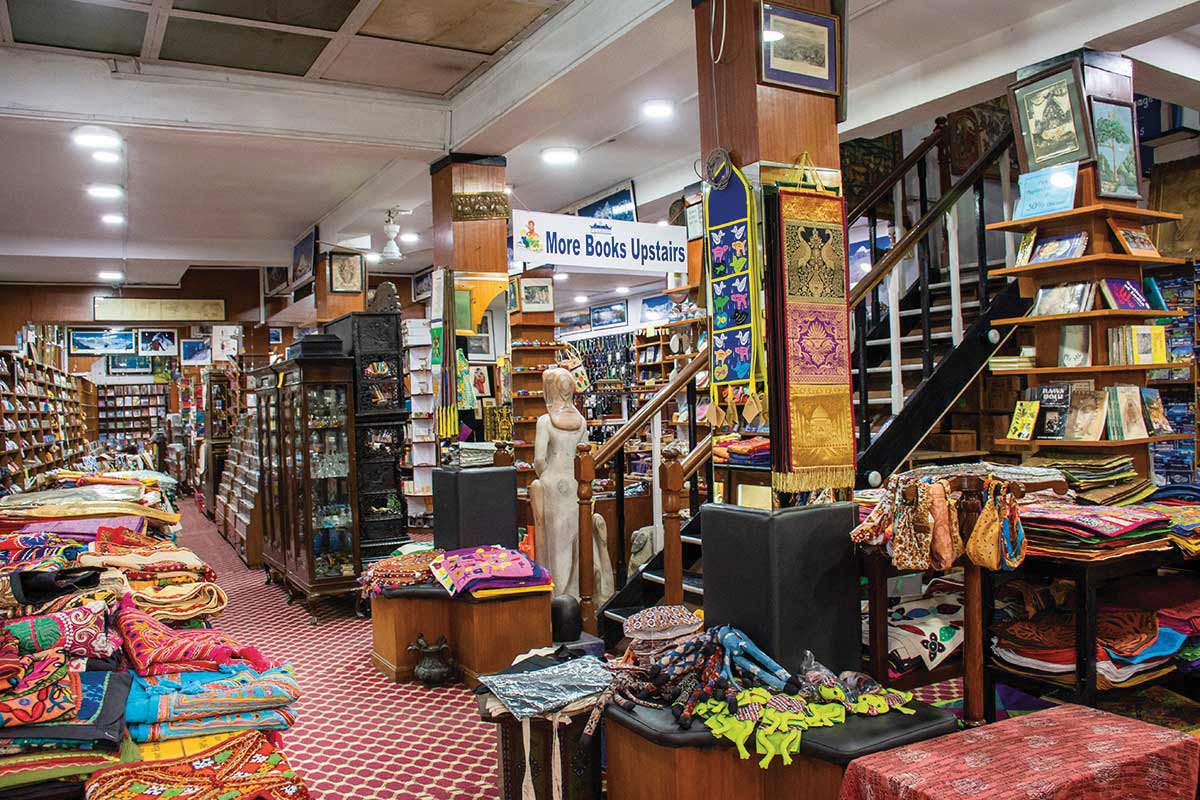Art as we know it is not only a visual representation; it has social importance and implications. The multiple facets of art are numerous, the more I think, the larger it grows! I felt compelled to reflect further when I visited the newest QFX movie hall at Chhaya Devi Complex, Thamel. Of course, the high-tech ambience was fascinating, but even more fascinating was the mural panel on the wall. It has the power to captivate anyone, firstly with its unfinished style and then, as you look on, the intensely interesting narrative keeps you so spellbound that I almost missed the movie!
Approximately 55x8 ft, the narrative starts with a scene of rustic Kathmandu, its traditional brick houses, carved wooden windows, terracotta tile thatched roofs, the traditional multi-tiered temple in the background, stone paved courtyard and walkways, farmers carrying vegetable in the kharpan, a large weighing scale type of implement, the pole resting on the shoulders of the carrier, used to carry vegetables and small household items, occasionally seen till today. The style of drawing the clouds is borrowed from the traditional style of Newari art, the pau:bha, which adds a decorative element, yet giving a traditional feel to the drawing. Although I wasn’t born in the 1960s, I have seen enough photographs of that period of Kathmandu to understand that this drawing is a recording of the different phases of evolution and development of the city of Kathmandu. The next narrative is of the era of the hippies, of hashish and marijuana, a large influx of tourists from the West coming to Nepal, the once forbidden Shangrila.
Prior to the 1950s, Nepal was a tightly secured and isolated region. In the 1970s it became central to the hippie trail. The 6000 mile route through Europe, Middle East, and central and southern Asia would bring in bohemian travelers in hordes. They came in search of peace, spirituality, love, and personal freedom, all very easily available in Nepal. Many also came to find tranquility from the hustle and bustle of Western cities in a quiet corner of the Himalayas. Jhochhen was the home of the hippies, which later became known as Freak Street. The hippie contingent liked to congregate on the worn stone paving, and also at many of the ancient temples. The famous Bollywood movie Hare Rama Hare Krishna, addressing the decadence of the hippie culture, was shot in Kathmandu. This era witnessed a boom in tourism and the awareness of Nepal rippled across hills, mountains, and seas.
Brilliantly illustrated in the wall mural is a Western female playing the guitar, surrounded by other elements and people representative of that era. The colorful halo-like effect in the background highlights the essence of the hippie culture, besides emanating its vibes. The famous Brazilian writer Paulo Coelho, often cited for his best-seller, The Alchemist, has his next book based on his hippie days, traveling from Amsterdam to Kathmandu by bus in the 1970s, releasing this summer. With the inflowing concept of Westernization and modernization, Kathmandu began to evolve and transform. Large areas of farmland in the valley were converted into residential and industrial estates, obscuring the once fabulous view of the mountains surrounding the Kathmandu valley.
Global politics made overland route to Nepal difficult, leading to the end of the halcyon days. The mural depicts the next big change in the socio-cultural change of Kathmandu, with the inflow of tourists as mountaineers, rafters, trekkers, and backpackers. The gush of adventure adrenaline took precedence in the 1980s, and the hub shifted from Jhonchen to Thamel, which transformed from a sluggish residential block to a concrete hodgepodge of lodges, restaurants, book shops, art and souvenir shops, and cafes playing Western cover bands, giving an ambiguous character to the space, and pinning it as a world tourist destination. Rickshaws and tourists with cameras ever ready to capture a moment in time and place the ancient temples and chaityas in the midst of sprawling urban landscape so well documents the shift in socio-cultural and economic change. The last bit of the mural has a very urban setting of contemporary times. Café and restaurant goers engrossed in conversation, tattoo centers, pubbing culture, and tourist guides take precedence in the illustration, reflective of the transformation not only of the culture but also the architectural landscape of Kathmandu, emphasizing on Thamel. Thamel is now a place of mingling, a business hub where Nepalis and foreigners stay connected.
This horizontal expanse of mural art had much more meaning than the aesthetics to me! It felt like a documentation of the various phases in the evolution and transformation of Kathmandu. Today, man-made disasters, natural disasters, neglect, inappropriate conservation, and uncontrolled development are major reasons that our heritage is vanishing faster than we can document or record them. Contemporary urban development can sometimes wipe out centuries of unrecorded history, as is the case happening currently in Kathmandu. As we strive to preserve as much as possible through various ways, such kind of art also become an option to document and record our history and transmit the knowledge of these places and epochs to newer generations. They serve also as a thread to conserve and communicate as visual proofs to the larger public about our past. Usually, such records are found in museums, archives, and other formal places of preservation, but having them in places like a movie theater, where people come in hordes, marks a shift in the methods of preservation, character, significance, and value of heritage.
My curiosity about this mural led me to an informal chat over lunch with the brain behind the concept, J Navin, the creative consultant of Integrated Creative Services. When asked about this mural, the first thing he mentioned was, “It is not an art based on the need of the company, or a décor element. The promoters were keen to use the space not for commercial purpose but for art’s sake, the theme left to the discretion of the artist.” This thought itself heightened my interest to know more. The promoters’ love for art, and interest to integrate art in public, or rather, commercial space, is itself thought-provoking. Recently, we can see a lot of mural or street art in and around Kathmandu, as well as globally, however, their presence in commercial spaces is not very common. The presence of the mural in the movie theater complex is a result of the personal interest of the promoters to raise awareness of art and engage the visitors in the cultural evolution of our nation.
The concept was rooted in a deep-seated thought of Navin, who wanted an art form that supported the space of a cinema theater. Based on its location, Thamel, a multi-cultural space, a junction of the old and new with a dynamic history evolved over a period of time, he thought further. Thamel being his mamghar (mother’s maiden house), he was familiar to the space since childhood and thus had witnessed the continuous change and development of Thamel since the 1970s. He wanted his narrative to reflect the local story in a visual art form, fitting the panoramic space and theme.
He explored various styles and options for painting on the wall—photo-finish, 3D—and finally selected the sketchy drawing style. Something that is a very reflective impression of Thamel itself. Thamel being ever-evolving, nothing looks perfectly finished here; the incompleteness of its physical and cultural landscape was the inspiration behind the sketchy style. The whole process took about three-four months, with the help of three visual artists, Anil Shahi, Saroj Tui, and Avinash Malla, to transform the concept into visual compositions. Through minimal use of color, the mural stands out in the space and does not blend with the ambience, and captures the changing socio-cultural dynamics, culturally, along with the physical landscape.











